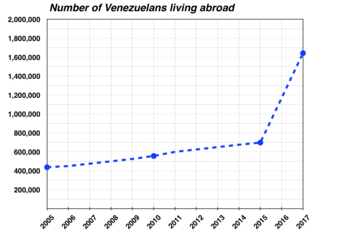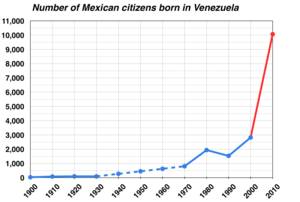Venezuelan refugee crisis
The Venezuelan migration and refugee crisis (also known as the Bolivarian diaspora), the largest recorded refugee crisis in the Americas,[8] refers to the emigration of millions of Venezuelans from their native country during the presidencies of Hugo Chávez and Nicolás Maduro because of the Bolivarian Revolution.[1][2][9] The revolution was an attempt by Chávez and later Maduro to establish a cultural and political hegemony,[10][11][12] which culminated in the crisis in Bolivarian Venezuela.[13] The resulting refugee crisis has been compared to those faced by Cuban exiles, Syrian refugees and those affected by the European migrant crisis.[14][15] The Bolivarian government has denied any migratory crisis, stating that the United Nations and others are attempting to justify foreign intervention within Venezuela.[16]
| Part of Crisis in Venezuela | |
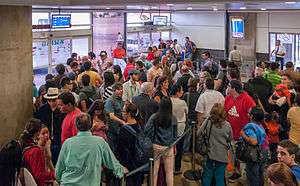 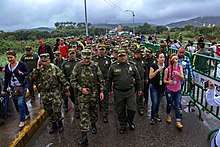  (top to bottom, left to right) Airline passengers leaving Venezuela from Maiquetia Airport; Colombian National Police leading Venezuelans into Cúcuta, Colombia; refugees seeking shade in a makeshift shelter | |
| Date | 1999–present (main phase since 2015) |
|---|---|
| Location | Venezuela |
| Also known as | Bolivarian diaspora |
| Cause | Social issues, political repression, crime, economic downturn, corruption, poverty, censorship, unemployment, hyperinflation, shortages, undernutrition, human rights violations and others[1][2][3] |
| Outcome |
|
| Crisis in Venezuela |
|---|
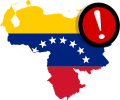 |
| Causes |
|
|
| Effects |
|
|
| Events |
|
|
| Elections |
|
|
| Protests |
| Timeline |
|
|
| Armed violence |
|
2017
2018 2019
2020 |
|
|
Newsweek described the "Bolivarian diaspora" as "a reversal of fortune on a massive scale", where the "reversal" is a comparison with Venezuela's high immigration rate during the 20th century.[2] Initially, upper class Venezuelans and scholars emigrated during Chávez's presidency, but middle- and lower-class Venezuelans began to leave as conditions worsened in the country.[17] It has caused a brain drain that affected the nation, due to the large number of emigrants who are educated or skilled.[18][19] After disappointment with opposition politics in the country, Venezuelans opposed to President Maduro also left the country, resulting with increased support for the Maduro government.[20]
During the crisis, Venezuelans have often been asked about their desire to leave their native country,[21] and over 30 percent of those asked in a December 2015 survey said that they planned to permanently leave Venezuela.[22] The percentage nearly doubled the following September as, according to Datincorp, 57 percent of respondents wanted to leave the country.[23] By mid-2019, over four million Venezuelans, around 13 percent of the country's population, had emigrated since the revolution began in 1999.[24][7][25] The United Nations predicted that by the end of 2019, there would have been over 5 million recorded emigrants during the Venezuelan crisis, over 15% of the population.[26] A late-2018 study by the Brookings Institution suggested that emigration would reach 6 million – approximately 20% of Venezuela's 2017 population – by the end of 2019,[27] with a mid-2019 poll by Consultares 21 estimating that up to 6 million Venezuelans had fled the country by this point;[5] estimates going into 2020 suggested that the number of Venezuelan migrants and refugees was overtaking the 6 million figure.[28] Six million was at this time the number of refugees from the Syrian Civil War, which started years before the recorded Venezuelan crisis and was considered the worst humanitarian disaster in the world at the time.[28][29]
History
During the 20th century, "Venezuela was a haven for immigrants fleeing Old World repression and intolerance" according to Newsweek.[2] Emigration began at low rates in 1983 after oil prices collapsed, though the increased rates of emigration, especially the flight of professionals, grew largely following the Bolivarian Revolution which was led by Venezuelan president Hugo Chávez.[30] Andrés Bello Catholic University Economic and Social Research Institute head Anitza Freitez said that emigration became more prominent during Chávez's presidency, attributing "individual development prospects and individual security" as the main reasons.[31]
Initial emigration
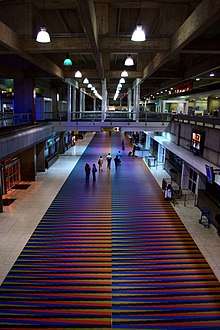
In 1998, when Chávez was first elected, the number of Venezuelans granted asylum in the United States increased between 1998 and 1999.[34] Chávez's promise to allocate more funds to the impoverished concerned wealthy and middle-class Venezuelans, triggering the first wave of emigrants fleeing the Bolivarian government.[35]
Additional waves of emigration occurred following the 2002 Venezuelan coup d'état attempt[36] and after the Chávez's re-election in 2006.[36][37] In 2009, it was estimated that more than one million Venezuelans had emigrated in the ten years since Hugo Chávez became president.[2] According to the Central University of Venezuela (UCV), an estimated 1.5 million Venezuelans (four to six percent of the country's total population) emigrated between 1999 and 2014.[18]
Crisis in Venezuela
Academics and business leaders have said that emigration from Venezuela increased significantly during the final years of Chávez's presidency and during the presidency of Nicolás Maduro.[39] Over time, emigration increased dramatically during the crisis and began to include lower-income Venezuelans, the people whom Chávez promised to aid and who were experiencing hunger in the country's economic crisis.[35] Venezuelan men initially left their wives, children and elderly relatives behind as they fled the country to find work in order to send money back home.[40] Mothers and children would later leave Venezuela to find their families as they grew exacerbated with the crisis as remittances could not sustain their daily needs.[40]
Election of Maduro and 2014 protests
After the election of Maduro in 2013 and as protests intensified in 2014, the emigration rate from Venezuela grew.[39][41] The Associated Press reported that the Venezuelan middle-class began to emigrate at this time as the crisis intensified with more shortages, inflation and unrest.[41]
Between 2012 and 2015, the number of Venezuelans who emigrated increased by 2,889 percent.[42] In 2015, PGA Group estimated that a total of about 1.8 million Venezuelans had emigrated.[43][44] The following year, an estimated 150,000-plus Venezuelans emigrated; scholars studying the diaspora, which The New York Times referred to as an "exodus", reportedly said that this was "the highest [number] in more than a decade".[35]
2017 constitutional crisis and Constituent Assembly elections
During the 2017 Venezuelan constitutional crisis, Colombia prepared for an increase of Venezuelan refugees.[45] According to the Colombian government, more than 100,000 Venezuelans emigrated to Colombia in the first half of 2017.[46] In the run-up to the 2017 Venezuelan Constituent Assembly elections, Colombia granted a Special Permit of Permanent Residence to Venezuelan citizens who entered the country before July 25; over 22,000 Venezuelans applied for permanent residency in Colombia in the program's first 24 hours.[47] The United Nations High Commissioner for Refugees found that host countries throughout Latin America recorded more than one million Venezuelans settling between 2014 and 2017.[48] The intergovernmental International Organization for Migration (IOM) had similar figures, with about one million Venezuelans emigrating between 2015 and 2017 in their data;[38] other statistics indicated that the IOM's numbers may have been conservative.[49]
2018 re-election of Maduro
After President Maduro's controversial re-election in May 2018, emigration continued; Venezuelans believed that Maduro's policies would not change, and conditions in the country would continue to deteriorate.[50] In September 2018, the United Nations High Commissioner for Refugees' regional representative officially compared the crisis with the migrant and refugee crisis caused by the Syrian Civil War.[15] The UNHCR and IOM released data in November 2018 showing that the number of refugees fleeing Venezuela since the Bolivarian revolution began in 1999 had risen to 3 million, around 10 percent of the country's population.[6]
Presidential crisis
Into 2019, president of the Venezuelan National Assembly Juan Guaidó declared himself acting president of Venezuela, beginning a presidential crisis.[51] On April 30, 2019, Guaidó attempted to lead a military uprising to remove Maduro from power, with the plan ultimately failing.[52][53] Emigration increased once more as Venezuelans predicted that they would not see significant changes and due to the blunders by the opposition.[40] As prospects of political change diminished in Venezuela, a July 2019 poll by Venezuelan-pollster Consultares 21 estimated that between 4.7 and 6 million Venezuelans had left the country.[5] By this point, the Venezuelan refugee crisis was considered the second-worst in the world, behind that from the Syrian Civil War.[54] At the end of 2019, President Maduro had firmly established himself in power and opposition to him had become discouraged, resulting with critics leaving the country while Maduro enjoyed more support from Venezuelans who remained.[20]
Causes
—Tomás Páez, Central University of Venezuela[35]
El Universal reported that according to the UCV study Venezuelan Community Abroad: A New Method of Exile, by Thomas Paez, Mercedes Vivas and Juan Rafael Pulido, the Bolivarian diaspora has been caused by the "deterioration of both the economy and the social fabric, rampant crime, uncertainty and lack of hope for a change of leadership in the near future".[1] The Wall Street Journal said that many "white-collar Venezuelans have fled the country's high crime rates, soaring inflation and expanding statist controls".[30] Studies of current and former citizens of Venezuela indicated that reasons for leaving the country included lack of freedom, high levels of insecurity and lack of opportunity.[18][19] Link Consultants director Oscar Hernandez said that causes for emigration include economic issues, although insecurity and legal uncertainties are the main reasons.[55]
Crime and Insecurity
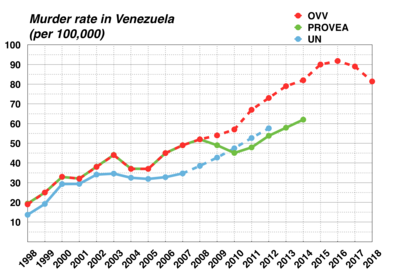
* UN dashed line is projected from missing data.
Venezuela's crime rate is a major cause of emigration.[1][30] According to sociologist Tomás Páez, Venezuelan parents and grandparents encourage young people to leave the country for their own safety.[18]
Venezuela deteriorated under Hugo Chávez, with political instability and violence increasing.[56] According to Gareth A. Jones and Dennis Rodgers in their book, Youth violence in Latin America: Gangs and Juvenile Justice in Perspective, the change of regime that came with Chávez's presidency caused political conflict, which was "marked by a further increase in the number and rate of violent deaths".[57] Roberto Briceño-León agrees, writing that the Bolivarian Revolution attempted to "destroy what previously existed, the status quo of society", with instability increasing as a result;[56] he also believes that the government furthered these social issues by attributing violence and crime to poverty and inequality, and boasting about reducing both as the Venezuelan murder rate increased.[56] The increase in the murder rate following the Chávez presidency has been attributed by experts to the corruption of Venezuelan authorities, poor gun control, and a poor judicial system.[58] The murder rate increased from 25 per 100,000 in 1999 (when Chávez was elected)[57] to 82 per 100,000 in 2014.[59]
In 2018, there were an estimated 81.4 deaths per 100,000 people, which makes this the highest rate in Latin America. Based on WHO standards, this makes violence an epidemic in 88% of the municipalities. There are also estimates that claims that Venezuela has the highest rates of kidnapping in the region and claims that kidnappings increased over twenty-fold from the beginning of the Chávez presidency to 2011.[60][61][62][63] There has also been a rise in extrajudicial executions in which the government force called Special Action Forces (FAES) carried out executions under the guise of security operations. More than 7,500 of the 23,000 violent deaths reported in 2018 were caused by resistance to authority. Between January and May 2019 there were 2,100 of such deaths reported.[63]
The murder rate in Venezuela had also decreased significantly between 2017 and 2020. In 2018, Venezuela's murder rate–described as the highest in the world–had begun to decrease to 81.4 per 100,000 people according to the Venezuelan Violence Observatory (OVV), with the organization stating that this downward trend was due to the millions of Venezuelans that emigrated from the country at the time.[64] The murder rate declined even further to 60.3 in 2019.[65]
Economy
A large push factor for the mass emigration was the economic situation of the country. The Venezuelan economic crisis, which is known as one of the most severe in recent economic history, was largely driven by the international oil prices dropping in 2014 and the governments inadequate response led to the exacerbation of the crisis and eventual 2017 recession, which is one of the worst recessions in the recent history of the Western hemisphere.[66]
Many business owners have emigrated to countries with growing economies since the Bolivarian Revolution.[1] The economic crisis experienced in Venezuela is worse than the events following the dissolution of the Soviet Union.[67] Since Hugo Chávez imposed stringent currency controls in 2003 in an attempt to prevent capital flight,[68] a series of currency devaluations has disrupted the Venezuelan economy.[69] Price controls and other government policies have caused severe shortages in Venezuela.[70] As a result of the shortages, Venezuelans must search for food (occasionally eating wild fruit or garbage), wait in line for hours, and live without some products.[71][72][73][74][75]
According to a 2018 Gallup analysis, "[g]overnment decisions have led to a domino-effect crisis that continues to worsen, leaving residents unable to afford basic necessities such as food and housing", with Venezuelans "believ[ing] they can find better lives elsewhere".[76]
Currently, the economy of Venezuela continues to experience stagflation, devaluation, a housing crisis, exacerbated external debt, and reductions of more than 35% reduction in GDP.[66] According to the International Monetary Fund (IMF), the Venezuelan economy contracted by 45% between 2013 and 2018. Venezuela's inflation rate passed over 100 percent by 2015, the world's highest inflation rate and the highest in the country's history.[77] By the end of 2018, this rate would rise to 1.35 million percent.[78] Additionally, GDP is predicted to decrease by an additional 25% by the end of 2019.[63]
Health and healthcare access
The economic and political situation in Venezuela led to increasing levels of poverty and scarcity of resources including food and medicine, greatly impacting the health and wellbeing of Venezuelans. In 2018, it was estimated that about 90% of the population was living in conditions of poverty. With regards to nutritional health, in 2017 Venezuelans lost an average of 11 kilograms of bodyweight and 60% of the population reported that they did not have sufficient resources necessary to access food.[66] Venezuelans remaining in country have little access to food items, in 2018 the Ministry of Food reported that 84% of items that are part of the basic food basket as are not available in supermarkets. Food production has also decreased by 60% between 2014 and 2018, the agricultural sectors has been weakened by both the Chavez and Maduro administrations, and food imports decreased by 70% between 2014 and 2016.[63]
Additionally, the general fracturing of the state led to reduced provision of health services and a deteriorating health sector. This low resource impoverished setting was the perfect breeding ground for the rise of diseases such as measles, diphtheria, tuberculosis, and malaria.[66] Medicine imports decreased by 70% between the years 2012 and 2016, only 15 out of 56 pharmaceutical companies still function, and over 150 pharmacies have closed since 2016. In late 2018, 85% of essential medicines were declared as being scarce, and according to the UN, 300,000 individuals are at risk because they have not had access to essential medicines for over a year. The Government has stopped publishing data on national level health indicators in 2015, but the situation is believed to be dire.[63]
Political repression

According to Venezuelan Community Abroad: A New Method of Exile, the Bolivarian government "would rather urge those who disagree with the revolution to leave, instead of pausing to think deeply about the damage this diaspora entails to the country".[1] Newsweek reported that Chávez "has pushed hard against anyone" who was not part of his movement, resulting in large swaths of science, business, and media professionals emigrating from Venezuela.[2]
Up to 9,000 Venezuelan exiles lived in the United States in 2014, with the number of exiles also increasing in the European Union.[1] The Florida Center for Survivors of Torture reported in 2015 that most of those they assisted since the previous year were Venezuelan migrants, with the organization providing psychiatrists, social workers, interpreters, lawyers and doctors for dozens of individuals and their families.[79]
Effects
Education
Many Venezuelan emigrants are educated professionals.[18] Iván de la Vega of the Simón Bolívar University (USB) found that 60 to 80 percent of students in Venezuela said that they want to leave the country and not return to 2015 conditions.[80] Primary and secondary school students were also affected, with media reports of children at school fainting from hunger.[81] In Venezuela's border regions, the school dropout rate is as high as 80 percent.[82][83]

According to a 2014 report that Iván de la Vega wrote, about 1 million Venezuelans had emigrated during the Chávez presidency but the number of academics was unknown;[84] UCV lost more than 700 of its 4,000 professors between 2011 and 2015.[85] About 240 professors left USB between 2009 and 2014,[84][85] with an additional 430 faculty members leaving from 2015 to 2017.[86]
Major reasons for the emigration of educational professionals include Venezuela's crime rate and low government pay.[84][85] According to the President of the Venezuelan Academy of Physical, Mathematical and Natural Sciences, Claudio Bifano, most of Venezuela's "technology and scientific capacity, built up over half a century" had been lost during Hugo Chávez's presidency. Despite 2 percent of the country's GDP being invested in science and technology, the number of papers published in international journals fell from about 1,600 to 1,000 (the 1997 figure, when Venezuela's technology budget was 0.3 percent of GDP) from 2008 to 2012.[87]
Mariano Herrera, the director of the Centre for Cultural Research and Education, estimated a shortage by about 40 percent of that necessary for teachers of mathematics and science in 2014. The Venezuelan government attempted to ease the teacher shortage by creating the Simón Rodríguez Micromission, reducing graduation requirements for educational professionals to two years of studies.[88] From January to March 2018, 102 of 120 positions at USB remained vacant.[89]
The Venezuelan Community Abroad: A New Method of Exile study reported that over 90 percent of Venezuela's more than 1.5 million emigrants were college graduates; 40 percent had a master's degree, and 12 percent had doctorates or post-doctorate degrees.[18][19] The study used official data verified abroad and surveys from Venezuelans who had decided to emigrate.[18]
Economy
Businesspersons emigrated from Venezuela due to government price controls and corruption, shortages, and foreign exchange controls. Accountants and administrators left for countries experiencing economic growth, such as Argentina, Chile, Mexico, Peru, and the US.[1] A Latin America Economic System study reported that the emigration of highly skilled laborers age 25 or older from Venezuela to OECD countries rose by 216 percent between 1990 and 2007.[2]
An estimated 75 percent of about 20,000 PDVSA (Petróleos de Venezuela) workers who left the company emigrated to other countries for work.[21] Former oil engineers began work on oil rigs in the North Sea and in the tar sands of western Canada;[2] the number of Venezuelans in Alberta increased from 465 in 2001 to 3,860 in 2011.[90] Former PDVSA employees also joined the more-successful oil industry in neighboring Colombia.[90] According to El Universal, "thousands of oil engineers and technicians, adding up to hundreds of thousands of man-hours in training and expertise in the oil industry (more meaningful than academic degrees)", and most of PDVSA's former executives, are working abroad.[1] After the PDVSA exodus, Venezuelan oil production decreased and work-related injuries increased.[90]
By 2019, more than 50,000 engineers and architects had left Venezuela in the six preceding years, with some of the Venezuelan labor force being replaced by foreign workers, including Chinese counterparts.[91]
Media and the arts
Actors, producers, TV presenters, news anchors, and journalists have reportedly left for Colombia, Florida, and Spain after the closing of media outlets by the Venezuelan government, or their purchase by government sympathizers. Musicians have emigrated to places receptive to their style of music.[1]
Healthcare
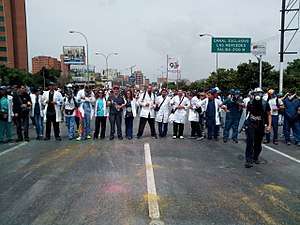
Physicians and medical staff, particularly those in private facilities, emigrated due to low pay and lack of recognition following the Venezuelan government's opposition to traditional 6-year programs. The Bolivarian government instead supports Cuba's training of "community medical doctors". The government reportedly restricted access to facilities and funding for physician training, which led to medical programs closing across the country.[1]
The Medical Federation of Venezuela's president, Douglas León Natera, said in April 2015 that more than 13,000 doctors (over 50 percent of the country's total) had emigrated. According to Natera, the resulting physician shortage affected public and private hospitals alike.[92] In March 2018 (after 22,000 doctors had fled Venezuela), the salary of many physicians was less than US$10 per month.[93]
In Latin American countries, the medical credentials of Venezuelan doctors are generally accepted. Opportunities for Venezuelans are limited in the United States, however, with physicians often becoming medical assistants or working in non-medical fields.[93]
Statistics
Migrant numbers
According to Iván de la Vega, the number of Venezuelans living abroad increased by over 2,000 percent from the mid-1990s to 2013 (from 50,000 to 1,200,000).[94] The median emigrant age is 32.[80]
The percentage of Venezuelans who said that they had family abroad increased from 10 percent in 2004 to nearly 30 percent in 2014.[3] In 2014, about 10 percent said that they were presently preparing to emigrate.[3] According to the UN High Commissioner for Refugees, "[b]etween 2003 and 2004, the number of (Venezuelan) refugees doubled from 598 to 1,256, and between 2004 and 2009, the number of Venezuelan refugees was five-fold higher, up to 6,221. By that date, there is also a log of 1,580 Venezuelan applicants for refuge."[31]
A late-2017 survey by Consultores 21 found that over four million Venezuelans had left the country due to the Bolivarian Revolution, and 51 percent of young adults said that they wanted to emigrate.[7] In 2018, it was estimated that over one million Venezuelans had plans to emigrate.[95] Emigrants primarily consist of professionals between 18 and 35.[3]
Characteristics of migrants
The characteristics of migrants are important to understand because these drive and affect vulnerabilities and migration patterns. According to an IOM survey of Venezuelan migrants in Brazil, Colombia, and Peru from 2018, respondents in Brazil were of average age 32, respondents in Colombia and Peru were of average age 30, males were 58% of the surveyed population, 5% of women surveyed in Colombia were pregnant, 3% in Brazil, and 1% in Peru, 31% percent of respondents Brazil and 39% of respondents in Colombia reported being without any regular migration status, and 41% of the respondents in Brazil were traveling alone, 37% in Colombia and 31% in Peru.[96] In a 2019 vulnerability study for migrants to Central America and the Caribbean, IOM found that 4% of respondents in the study were pregnant women, 32% of females said that they were affected by discrimination and 5% of these women were pregnant, 58% of females reported lack of healthcare access and 57% of males did, and 65% of respondents travel alone vs 35% travel in a group.[97]
Colombian population
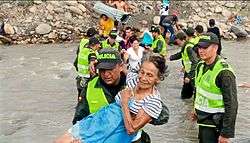
According to Universidad de los Andes sociologist Raquel Alvarez, 77 percent of immigrants to Venezuela during the 1990s were from Colombia. By the early 2010s, the Colombian immigrants were disappointed with Venezuela's economic collapse and discrimination by the government and its supporters. Between tens of thousands and 200,000 Colombians left Venezuela in the years before 2015. The Colombian Ministry of Foreign Affairs reported that visas to Colombia increased by 150 percent between March 2014 and March 2015, and repatriation assistance of Colombian-Venezuelans reached a record number in the first quarter of 2015. Martin Gottwald, deputy head of the United Nations refugee agency in Colombia, said that many of the 205,000 Colombian refugees who had fled to Venezuela may return to Colombia. The number of repatriating Colombians concerned the Colombian government, due to its effect on unemployment and public services.[98]
Jewish population
The Jewish population in Venezuela has, according to several community organizations, declined from an estimated 18,000–22,000 in the year 2000[99] to about 9,000 in 2010.[100] Community leaders cite the economy, security, and increased antisemitism as major reasons for the decline. Some have accused the government of engaging in, or supporting, antisemitic action and rhetoric.[100][101][102] In 2015, it was reported that the Jewish population had declined to 7,000.[103]
Refugee life
Aid
Organizations and events have been created to assist Venezuelan emigrants. The website MeQuieroIr.com (Spanish: "I want to go") was created by a former public-affairs employee of PDVSA who moved to Canada, and quickly became popular among Venezuelan emigrants.[21][104][105] In June 2015, the first annual Migration Expo was held in Caracas; the event included support groups, study-abroad assistance, and help with the emigration process.[106] The Somos Diáspora network, consisting of a website and radio station in Lima, Peru, was launched in May 2018 to provide Venezuelan entertainment, news and migration information to the diaspora.[107]
Problems
Crime
Mauro Medina, Peruvian Minister of the Interior[108]
The Maduro government often granted the emigration of Venezuelan criminals and organized crime into regional countries, with nations like Aruba, Colombia, Panama, Peru and the United States experiencing higher crime as a result.[109][110]
In June 2018, a group of Venezuelans robbed a jewelry store in Jockey Plaza, Peru, and fled the country.[111] On July 27, 2018, four Venezuelans shot and injured one police officer while robbing a store in the country, though they were later captured.[112][113] The "Tren de Aragua" (Train of Aragua) gang of Venezuela–which flourished in their native country's impunity where they directed robbery, kidnapping and murder operations–saw five of their members arrested in August 2018 for planning a bank robbery at a Peruvian shopping mall.[109][114][115] The Venezuelan gang members were found by the National Police of Peru equipped with firearms, a grenade, and a map of the bank.[114] At least seventy-two Venezuelans were imprisoned in Peru by mid-2018.[109]
On February 19, 2019, a group of masked Venezuelan and Colombian migrants attempted to break-in at the Inkaterra Amazon Reserve lodge in the Madre de Dios region of Peru, resulting in the death of a local tour guide. A total of 53 guests, including American and Chinese tourists, were safe.[116][117]
Discrimination
Venezuelan refugees have occasionally faced xenophobia and discrimination in destination countries.[118] The International Organization for Migration has increased awareness that refugees are vulnerable to trafficking and prostitution.[118] Venezuelans in Panama experience xenophobia due to competition with local residents, and Panamanian nationalist movements have used anti-Venezuelan-refugee rhetoric to gain support.[119]
In Brazil, at least 1,200 Venezuelans were forced from refugee camps by residents of Pacaraima on August 18, 2018 after the family of a local merchant told the authorities that he had been assaulted by a group of Venezuelans. However, two days later the authorities said the assailants’ identity and nationality had not been confirmed.[120] The residents of the city destroyed the migrant camps.[121][122][123]
Prostitution
Many Venezuelan women in Colombia resort to prostitution to earn a living,[124] and some fight to the death with their Colombian counterparts.[125] In "La Chama", a Panamanian hit song by Mr. Saik, the singer mocks a Venezuelan woman that resorts to prostitution; the singer received death threats from migrants.[119] Educated Venezuelan emigrants have also turned to prostitution because they can no longer continue the careers they pursued.[126]
Health
Infectious diseases
The re-emergence of measles, and other communicable diseases as a result of Venezuela's physician shortage raised concerns in destination countries that refugees would spread disease throughout the region. Measles outbreaks occurred in Brazil, Colombia, and Ecuador in areas in which Venezuelan refugees lived; most of the infected were refugees.[127] Increases in malaria and diphtheria in Venezuela have also raised concerns in neighboring countries.[81] As of August 2019, Venezuelan migrants will be given regional vaccination cards to make sure they receive vaccines and are not given double doses. This move was agreed by health officials from the United States, Colombia, Ecuador, Panama, Canada, Haiti, the Dominican Republic, Argentina, Peru and Paraguay.[128]
Mental health
Many Venezuelan refugees suffer from posttraumatic stress disorder due to the traumatic events they have experienced within their native country.[129] Migrants experience both physical and psychological symptoms from their traumas which are caused by violence in Venezuela, leaving relatives behind, and adapting to the culture of their host countries.[129] Some of the main causes of hospitalization among Venezuelan refugees in Peru are mental health related.[130]
Traveling
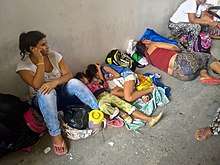
Venezuelans have emigrated in a number of ways, and images of migrants fleeing by sea have been compared to Cuban exiles.[35] Many refugees travel by foot for thousands of miles due to their inability to afford other travel methods, trekking over mountain ranges, walking distances on highways towing suitcases, hitchhiking when able and fording rivers to escape the crisis.[31][131] The majority begin their travels at the border town of Cucuta, Colombia and then leave to their individual destinations.[131] Refugees are also susceptible to fake travel guides and robberies along their journey.[31]
Those who leave by foot are known as los caminantes (the walkers); the walk to Bogotá, Colombia is 350 miles, and some walk hundreds of miles further, to Ecuador or Peru.[132] Alba Pereira, who helps feed and clothe about 800 walkers daily in Northern Colombia, said in 2019 she is seeing more sick, elderly and pregnant among the walkers.[132] The Colombian Red Cross has set up rest tents with food and water on the side of the roads for Venezuelans.[133] Venezuelans also cross into northern Brazil, where UNHCR has set up 10 shelters to house thousands of Venezuelans.[133] Images of Venezuelans fleeing the country by sea have raised symbolic comparisons to the images seen from the Cuban diaspora.[35]
Destinations
The number and characteristics of people leaving Venezuela can be hard to track. General estimates have been made that capture the scale of the migration. Migration flow from Venezuela to significant destinations (which include most of Latin America, North America, and parts of Europe) has increased from 380,790 in 2005 to 1,580,022 in 2017 (IOM, 2018a), where the estimates are based on each receiving government estimation.[134] There are many migrants who enter a receiving country with regular status, but there are many who do not. The number of those who enter irregularly is difficult to estimate because of their immigration status.
The top ten destinations (significant destinations) for Venezuelan emigrants are Colombia, Peru, the United States, Spain, Italy, Portugal, Argentina, Canada, France, and Panama.[135] Tens of thousands of Venezuelans have also moved to other locations, including Trinidad and Tobago[136] and other countries in the Americas and Europe.[18][137]
Venezuelans have fled to over 90 countries in pursuit of a better life.[138] Between 2015 and 2017, Venezuelan immigration increased by 1,388 percent in Chile, 1,132 percent in Colombia, 1,016 percent in Peru, 922 percent in Brazil, 344 percent in Argentina and Ecuador, 268 percent in Panama, 225 percent in Uruguay, 104 percent in Mexico, 38 percent in Costa Rica, 26 percent in Spain, and 14 percent in the United States.[14]
United States
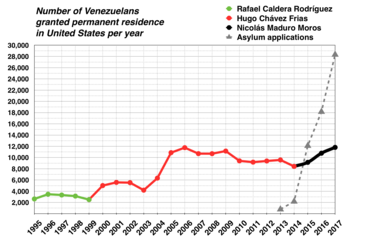
The United States is one of the main destinations for Venezuelan emigrants.[55][18][31] The number of U.S. residents who identified as Venezuelan increased by 135 percent between 2000 and 2010, from 91,507 to 215,023.[142] In 2015, it was estimated that about 260,000 Venezuelans had emigrated to the United States.[80] According to researcher Carlos Subero, "[t]he vast majority of Venezuelans trying to migrate enter the country with a non-immigrant tourist or business visa", statistics showing that 527,907 Venezuelans remain in the United States with non-immigrant visas.[3] The Latin American and Caribbean Economic System (SELA) reported that in 2007, 14 percent of Venezuelans 25 and older in the United States had a doctoral degree; above the U.S. average of nine percent.[31]
The largest community of Venezuelans in the United States lives in South Florida.[18] Between the years 2000 and 2012, the number of legal Venezuelan residents in Florida increased from 91,500 to 259,000.[143] In 2015, the Venezuelan Refugee Assistance Act was proposed by four Florida delegates to the United States House of Representatives.[143] The act would adjust the status of Venezuelans without a criminal record or involvement in persecution who arrived in the United States before January 1, 2013, with a deadline of January 1, 2019 to apply for adjustment.[143] One chief sponsor, U.S. Representative Carlos Curbelo, said: "This bill will help those Venezuelan nationals who have made a new home in the United States to remain here if they choose to, since it is dangerous to return home".[143] The bill was sent to the House Judiciary Committee.[143]
Latin America and the Caribbean
Latin American countries, such as Argentina, Brazil, Chile, Colombia, Ecuador, Mexico, Peru and Panama, are popular destinations for Venezuelan emigrants.[39]
Argentina
.jpg)
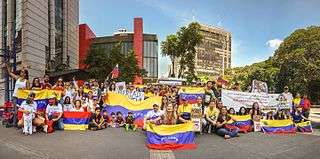
Venezuelan immigration has increased significantly since 2005, from 148 people annually to 12,859 in 2016. Over 15,000 Venezuelans emigrated to Argentina from 2004 to 2014, of whom 4,781 have obtained permanent residency.[144][135] The number of Venezuelan immigrants increased by 500 percent from 2014 to 2016, to 600 per week. Between 2014 and mid-2017, 38,540 Venezuelans filed residency applications in Argentina.[135][145]
Venezuelans emigrating to Argentina face several obstacles, such as the cost of plane fare, due to the distance between the countries compared to that of the neighboring Colombia and Brazil. Attracted by better living conditions, many risk the trip by land; Marjorie Campos, a Venezuelan woman who was eight months pregnant, traveled by bus for 11 days across Colombia, Ecuador, Peru and Chile to reach the Argentine city of Cordoba.[146]
Brazil
Col. Edvaldo Amara, Roraima civil-defense chief[35]
As socioeconomic conditions worsened, many Venezuelans emigrated to neighboring Brazil. Tens of thousands of refugees traveled through the Amazon basin seeking a better life, some traveling by foot and paying over $1,000 to be smuggled into larger cities. The Brazilian government increased its military presence on the border to assist refugees on its roads and rivers.[35] Over 70,000 refugees[147] entered the border state of Roraima in northern Brazil in late 2016, straining local resources.[17] Hundreds of children from Venezuela are enrolled in schools near the Brazil-Venezuela border, and about 800 Venezuelans entered Brazil daily by 2018.[148]
On August 7, 2018, the regional government requested that the Supreme Federal Court of Brazil close the border, and later that day the Supreme Federal Court denied the request on constitutional grounds.[149][150]
Colombia
Colombia, a country that borders Venezuela and has a long history with the country, has received the largest number of Venezuelan migrants. Following the reopening of the Colombian border after the Venezuela–Colombia migrant crisis, many Venezuelans began to emigrate into the country.[151] Since then, Colombia has accepted many Venezuelan refugees and has attempted to give legal status to them.[152] The aid provided by the Colombian government to Venezuelan refugees has been costly, and multiple international partners have intervened to provide assistance.[152] Assistance provided by Colombia to Venezuelans ranges from emergency room visits to public education for children; all provided by the Colombian government for free.[152] In August 2019, President Ivan Duque announced that Colombia would grant citizenship to 24,000 children born in Colombia to migrant Venezuelan parents, in order to prevent them from being stateless.[153]
In July 2016, over 200,000 Venezuelans entered Colombia to purchase goods due to shortages in Venezuela.[154] On August 12, 2016, the Venezuelan government officially reopened the border; thousands of Venezuelans again entered Colombia to escape the Venezuelan crisis.[154] Colombia's oil industry has benefited from skilled Venezuelan immigrants, although the country began deporting unauthorized immigrants in late 2016.[151]
According to the Colombian government, more than 100,000 Venezuelans emigrated to Colombia in the first half of 2017.[46] In the run-up to the 2017 Venezuelan Constituent Assembly elections, Colombia granted a Special Permit of Permanent Residence to Venezuelan citizens who entered the country before July 25; over 22,000 Venezuelans applied for permanent residence in the permit's first 24 hours of receiving applications.[47] By the end of November 2017, over 660,000 Venezuelans were in Colombia, twice as many as there had been in June.[48] At the end of 2018, there were more than 1.2 million Venezuelans in Colombia.[155] Between April and June of the 2018, Colombia registered more than 442,000 Venezuelans who were irregularly in the country through a registration process called RAMV.[156] Beginning in January 2020, the Colombian government announced it would offer work permits to hundreds of thousand of Venezuelans living in Colombia, allowing them to integrate into the formal economy.[153]
Costa Rica
The number of Venezuelan asylum seekers in the country increased from only 200 in 2015 to 1,423 in 2016, going up to 2,600 in 2017;[157] this has been a subject that discussed jointly by the governments of both Costa Rica and Panama in a bilateral summit.[158] Of the total of 6,337 refugee applications in the country in 2017, 50% were from Venezuelans.[159]
Chile
Between 2015 and 2017, Venezuelan emigration to Chile increased by 1,388 percent.[14] In 2016, Venezuelans emigrated to Chile due to its stable economy and simple immigration policy. According to the Chilean Department for Foreigners and Migration, the number of Chilean visas for Venezuelans increased from 758 in 2011 to 8,381 in 2016; 90 percent were work visas for Venezuelans aged 20 to 35. Since international travel by air is difficult (especially due to the value of the Venezuelan bolívar), many Venezuelans must travel overland through dangerous terrain to reach Chile. After arriving, they must start a new life. According to Catholic Chilean Migration Institute executive secretary Delio Cubides, most Venezuelan immigrants "are accountants, engineers, teachers, the majority of them very well-educated" but accept low-paying jobs so they can meet visa requirements and remain in the country.[151][160]
Mexico
The Venezuelan population in Mexico increased from 2,823 in 2000 to 10,063 in 2010, a 357 percent increase in Venezuelan-born people living in Mexico.[161] Mexico granted 975 Venezuelans permanent identification cards in the first five months of 2014, double the number of ID cards issued in 2013.[39] The Mexican government claims that 47,000 Venezuelans currently reside in Mexico.
Dutch Caribbean islands
Once a tourist and vacation destination for Venezuelans, the islands of Aruba and Curaçao require Venezuelan citizens to have at least $1,000 USD in cash prior to immigrating, which is over five years' income for a Venezuelan working a minimum-wage job. Patrols and deportation of Venezuelans have increased, and Aruba has dedicated a stadium to hold up to 500 Venezuelan migrants facing deportation.[35]
The journey to Curaçao is an often-dangerous 60-mile (97 km) trip that includes dangerous waters monitored by the Dutch Caribbean Coast Guard as well as armed gangs.[35] Venezuelans are brought near the island's shore, dumped overboard and forced to swim to land, where they meet contacts to set up their new lives. Curaçao authorities state that common jobs held by Venezuelans on the islands are to serve tourists, with their work ranging from cleaning restaurants to being active in the sex trade.[35] The Dutch Caribbean Coast Guard estimates that only five to ten percent of boats carrying Venezuelan migrants are intercepted.[35]
Peru
Compared to other destination countries, The New York Times described Peru as being more welcoming to Venezuelan refugees.[163]
Peruvian President Pedro Pablo Kuczynski introduced legislation in 2017 granting existing Venezuelan nationals in Peru a Temporary Permit of Permanence (PTP). The Inter-American Commission on Human Rights approved, encouraging other Latin American countries to adopt similar measures. The Venezuelan Union in Peru, a non-governmental organization, announced that they would present President Kuczynski's actions to the Norwegian Nobel Committee and nominate him for the Nobel Peace Prize:[164]
[W]hile other countries build walls, in Peru, bridges are built to bring citizens closer and protect their most elementary fundamental rights, so with overwhelming hope we will present this nomination of President Pedro Pablo Kuczynski, not only in search of this award, but also to place in the international debate the abuses of which Latin American migrants are victims in some parts of the world.
In August 2017, a little over three months after the decree, over 40,000 Venezuelan refugees had entered Peru.[165] By mid-2018,[166] over 400,000 Venezuelans had emigrated to Peru.[167] In a United Nations survey, 61.9 percent of Venezuelans who moved to Peru worked in retail, tourism or a similar position; 9.4 percent worked in industry and construction.[168] Forty-six percent earned between 984 and 1,968 soles ($300–600) per month; 34 percent earned between 656 and 984 soles ($200–300), and 11 percent earned less than 656 soles per month (less than $200).[168] By the end of 2018 more than 670,000 Venezuelans had emigrated to Peru.[169]
In June 2019, Peruvian president Martín Vizcarra announced that Peru would only accept Venezuelans with passports and visas following June 15, 2019.[40] In the week before the deadline, about 50,000 Venezuelans scrambled to enter Peru while they had the opportunity.[40] In August 2019, the government announced that it will take stricter measures to boost up security at its border with Ecuador to prevent illegal immigration after previous measures showed 90% drop in legal crossings.[170]
Trinidad and Tobago
It is estimated that there are over 40,000 Venezuelan citizens residing in Trinidad and Tobago [171], whilst 16,523 have officially regularised their immigration status [172]. Venezuelans have historically emigrated, both legally and illegally, to Trinidad and Tobago due to the country's relatively-stable economy, access to United States dollars, and close proximity to eastern Venezuela.[173] There are legal transport routes both by air and sea: direct flights to the islands leave from the Venezuelan cities of Maturin, Caracas and Isla Margarita, and there is ferry service from the Venezuelan town Guiria and the city of Chaguaramas on Trinidad, or from the Venezuelan town of Tucupita to Trinidad's Cedros. Illegal routes also exist between Venezuela's east coast and the Gulf of Paria.[174] About 14,000 Venezuelans entered Trinidad and Tobago between January 1 and May 10, 2016, with 43 percent reportedly overstaying their visas.[173] Venezuelans who remain often seek employment on the island; some, women in particular, enter the sex industry.[175]
Europe
In February 2018, almost 1,400 Venezuelans flew across the Atlantic Ocean into Europe. Most of these (1,160) sought asylum in Spain. The number was a significant increase from 150 in February 2016, and 985 in February 2017. Cultural and linguistic ties are the main reason why Spain is the most popular destination among European countries for Venezuelan migrants.[176] Venezuelan citizens can travel the Schengen Area countries without a visa.
Spain
The vast majority of Venezuelan-born people residing in Europe live in Spain and/or have acquired Spanish citizenship, either in Venezuela or in Spain. Between 2015 and 2018 the number of Venezuelan-born residents in Spain increased from 165,893 to 255,071 people.[177] As of 2019, the number of Venezuelans in Spain exceeds 300,000 people, implying a mass arrival in the 2018–2019 period.[178]
Hungary
Despite its anti-immigration rhetoric following the European migrant crisis, the government of Viktor Orbán has welcomed hundreds of Venezuelan migrants who have proven to have at least one Hungarian ancestor. However, the reception has not been as positive, with several citizens complaining to the police about the presence of black Venezuelans in the surroundings of the spa of Balatonoszod, where immigrants were initially housed.[179]
Israel
Due to allegations of antisemitism[180] against the government of Venezuela, based in part on its political alignment with foreign actors like Iran, Palestine and Syria,[181] and compounded by the ongoing economic crisis, much of Venezuela's Jewish community has taken advantage of Israel's Law of Return to emigrate to Israel and take up residence there. As much as 60% of Venezuela's Jewish population has sought refuge in Israel since Chávez took office in 1999, when there were 22,000 Jews in Venezuela. This number has been dwindling to around 6,000 Jews still left in Venezuela as of 2019.[182] Over 11,000 Venezuelans have emigrated to Israel since the start of the crisis.[183]
Humanitarian Response
International
_set_up_a_U.S._Navy_medical_site._(48240732662).jpg)
Intergovernmental organizations

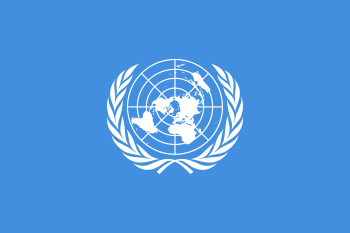
Governments
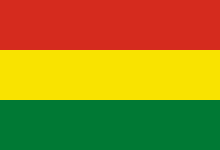

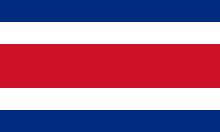


The Venezuelan migrant crisis is unique in the world of humanitarian crisis and because of this, has been slow in receiving international attention and aid. The crisis is not an easily defined refugee crisis, and the UN has defined the flow of emigrants as a mixed flow population. This means that those leaving the country are both general migrants and specifically defined asylum-seekers. For this reason, the UN has created a joint platform between UNHCR and IOM, called the Regional Inter-Agency Coordination Platform, tasked with assisting those emigrating from Venezuela. UNHCR has issued a call to apply the wider definition of refugee outlined in the Cartagena Declaration of 1984 to Venezuelan migrants. This would allow this group of individuals to be aided as refugees.[63]
In April 2019, non-governmental organizations Human Rights Watch and the Johns Hopkins Bloomberg School of Public Health to publish a report and asked the United Nations (UN) to define the situation in Venezuela as a complex humanitarian emergency.[195]
Visa restrictions
As of December 2019, governments of 10 countries (mostly in Latin America and Caribbean) have introduced special visa requirements for Venezuelan citizens seeking to enter these countries.[196] According to the UN High Commissioner for Human Rights Michelle Bachelet, the introduction of visa requirements could cause Venezuelans in resorting to people-smugglers and human traffickers for illegal entry.[197] Some countries such as Guatemala, Caribbean Netherlands and the Dominican Republic, will still allow Venezuelans to enter visa-free if holding a valid visa/residence permit from a particular third country, such as Canada or the United States.
By 2021, the European Union will introduce an electronic authorization system for Venezuelans planning to visit the Schengen Zone, called ETIAS or European Travel Information and Authorization System.[198] This means that Venezuelans wanting to visit the Schengen Area countries will require to submit personal data in advance and pay a processing fee, except for children. In March 2020, the Spanish government ruled out on imposing visa requirements on Venezuelans seeking to enter Spain or the Schengen Area.[199]
| Country | Visa restrictions introduced | Exemptions | Notes |
|---|---|---|---|
| October 1, 2017 | Visa exempt for holders of a valid visa issued by USA, Australia, Canada, or United Kingdom and has been used at least one time to enter these countries.[200] Transit visa not required if connection time is under 12 hours. | In October 2018, the Panamanian government announced that it will grant Venezuelans a multiple entry visa for a period of 5 years. From December 2019, it will also accept expired passports for entering the country.[201] | |
| November 20, 2017 | No exemptions | ||
| March 19, 2018 | Visa exempt for holders of a valid visa issued by Canada, United States or a Schengen Member State. | ||
| July 19, 2018[202] | No exemptions | ||
| June 15, 2019 | Visa exempt for residence permit holders of the Pacific Alliance countries.[203] | Venezuelans can apply for special humanitarian visas at the Peruvian embassies consulates based in Venezuela (Caracas and Ciudad Guayana), Colombia (Bogotá, Medellín, and Leticia), and Ecuador (Cuenca, Guayaquil, Quito, Machala, and Loja). It also accepts expired passports for entry into the country. | |
| June 17, 2019[204] | No exemptions | ||
| June 22, 2019 | Visa exempt for holders of official and diplomatic passports. | The Chilean Foreign Ministry is offering Venezuelans a "democratic responsibility visa", which allows them to stay in Chile for one year, and can be extended for an additional 12 months. The visa can be applied at Chilean embassy in Caracas and worldwide. It also accepts expired passports for entry into the country. | |
| August 25, 2019 | No exemptions | The Ecuadorian government is offering Venezuelans special visas (including humanitarian and temporary permits) to enter the country. It also accepts expired passports for entry into the country. | |
| December 16, 2019 | Visa exempt for holders of a valid visa issued by Canada, United States or a Schengen Member State. Also applied to holders of official and diplomatic passports. | ||
| TBA[205] | Visa exempt for holders of a valid visa or residence permit issued by Canada, United States, Ireland, United Kingdom or a Schengen Member State, including French overseas departments or overseas collectivities. | The visa restrictions are temporary due to the current situation in Venezuela. The visa-free entry will be re-introduced once the situation improves.[206] |
Catholic Church
The Catholic Church in Peru organized programs to help Venezuelan refugees, dedicating masses and collections to the migrants.[207]
Quito Declaration
The Quito Declaration on Human Mobility and Venezuelan Citizens in the Region was signed in the Ecuadorian capital on September 4, 2018 by the representatives of Argentina, Brazil, Chile, Colombia, Costa Rica, Ecuador, Mexico, Panama, Paraguay, Peru and Uruguay. Bolivia and the Dominican Republic did not sign the document. The last nation argued that it was an observer country in the meeting that Venezuela decided not to attend.[208]
The event sought to exchange information and achieve a coordinated response to the massive migratory flow of Venezuelans. At the meeting, the countries reiterated their concern about the deterioration of the internal situation caused by mass migration, so they call to accept the opening of humanitarian assistance in which the cooperation of governments and international organizations is agreed to decompress what they consider a critical situation.[208]
Among the most important points agreed by the governments of the region are the acceptance of expired travel documents, identity card of the Venezuelans for migratory purposes and the exhortation to the government of Nicolás Maduro to take urgently and as a priority the necessary measures for the timely provision of identity cards, passports, birth certificates, marriage certificates and criminal records, as well as apostille and legalization.[209]
Domestic
President Nicolás Maduro said that international reports of millions of Venezuelans emigrating are "propaganda", and Venezuelans regret leaving the country because they end up "cleaning toilets in Miami".[95] Angry Venezuelans criticized Maduro, saying that they would rather clean toilets in another country than live in Venezuela.[95] In September 2018, President Maduro said that his countrymen had been victims of a hate campaign, and that in Peru they had only found racism, contempt, economic persecution and slavery.[210]
Venezuelan Vice President Delcy Rodríguez denied her country has a humanitarian and migration crisis, calling it "fake news". She argued that the humanitarian crisis would be "an excuse for the United States to invade Venezuela and deepen the economic war."[211][212]
President of the National Constituent Assembly and Vice President of the United Socialist Party of Venezuela, Diosdado Cabello, claimed that the migrant crisis is being staged as part of a right-wing conspiracy to overthrow the government of Nicolás Maduro, and that images showing Venezuelans fleeing across South America on foot had been manufactured.[213]
Back to the homeland plan
In 2018, the Bolivarian government introduced the "Back to the homeland plan" (Spanish: Plan Vuelta a la Patria) that offers the payment of tickets to Venezuelan migrants who want to return to their country.[214][215] On August 28, 2018, 89 Venezuelans returned to Venezuela from Peru. The program was implemented in Peru and other in other South American countries such as Ecuador and Chile.[216] However, the program has achieved very little for the return of their fellow citizens.
See also
- Crisis in Venezuela (2012–present)
- Venezuelan protests (2014–present)
- Vietnamese boat people
- North Korean defectors
- Refugees of the Syrian Civil War
- European migrant crisis
- List of diasporas
- Visa requirements for Venezuelan citizens
- Anti-Venezuelan sentiment
- Emigration from Colombia (during the Colombian conflict)
References
- Olivares, Francisco (September 13, 2014). "Best and brightest for export". El Universal. Archived from the original on September 16, 2014. Retrieved September 24, 2014.
The Bolivarian diaspora is a reversal of fortune on a massive scale
- "Hugo Chavez is Scaring Away Talent". Newsweek. June 30, 2009. Retrieved September 24, 2014.
The Bolivarian diaspora is a reversal of fortune on a massive scale
- "Ten percent of Venezuelans are taking steps for emigrating". El Universal. August 16, 2014. Retrieved April 26, 2015.
- "Situation Response for Venezuelans". r4v.info. Retrieved April 17, 2020.
- Wyss, Jim (August 13, 2019). "A nation is vanishing: Has Venezuela lost almost 20 percent of its population?". The Miami Herald. Retrieved August 15, 2019.
- "Number of refugees and migrants from Venezuela reaches 3 million". UNHCR. UNHCR, IOM. November 8, 2018. Retrieved November 13, 2018.
- "Gracias a las malas políticas del Gobierno bolivariano, más de 4 millones de venezolanos se han ido del país (encuesta)". La Patilla (in Spanish). January 19, 2018. Retrieved January 20, 2018.
- • Board, Editorial (February 23, 2018). "Latin-America's worst-ever refugee crisis: Venezuelans". The Washington Post. Retrieved February 25, 2018.
This human outflow, ... is the largest displacement of people in Latin American history
- Hylton, Wil S. (March 9, 2018). "Leopoldo López Speaks Out, and Venezuela's Government Cracks Down". The New York Times. ISSN 0362-4331. Retrieved March 12, 2018.
Venezuela is the most urgent humanitarian disaster in the Western Hemisphere, producing the largest exodus of refugees in the history of the Americas
- "Venezuela's mounting refugee crisis". Financial Times. April 20, 2018. Retrieved April 22, 2018.
- "Venezuela's exodus: Forced to flee". Al Jazeera. September 15, 2018. Retrieved September 15, 2018.
Latin America is facing the largest refugee crisis in its history as hundreds of thousands of people flee Venezuela to escape severe economic hardship.
- Kurmanaev, Anatoly (May 17, 2019). "Venezuela's Collapse Is the Worst Outside of War in Decades, Economists Say". The New York Times. ISSN 0362-4331. Retrieved May 18, 2019.
Venezuela has lost a tenth of its population in the past two years as people fled, even trekking across mountains, setting off Latin America’s biggest ever refugee crisis.
- Hylton, Wil S. (March 9, 2018). "Leopoldo López Speaks Out, and Venezuela's Government Cracks Down". The New York Times. ISSN 0362-4331. Retrieved March 12, 2018.
- • Maria Delgado, Antonio (August 28, 2014). "Venezuela agobiada por la fuga masiva de cerebros". El Nuevo Herald. Retrieved August 28, 2014.
The massive emigration of Venezuelans, a trend that was unprecedented in the republican history of the nation, is mainly motivated by personal insecurity, legal insecurity and lack of options to progress under the Bolivarian regime
- Weddle, Cody (March 18, 2017). "More desperate college grads flee Venezuela". WPLG. Retrieved October 15, 2017.
some academics refer to the exodus in its totality as the Bolivarian diaspora
- Wyss, Jim (July 25, 2017). "As Venezuela faces critical week, Colombia prepares for a wave of migrants". The Miami Herald. Retrieved October 15, 2017.
And as conditions in Venezuela worsen, the “Bolivarian Diaspora” is likely to keep growing. One measure of the desperation:the number of Venezuelans seeking asylum abroad tripled from 2015 to 2016.
- Manner, Benedict (September 5, 2017). "A family bereavement brings home Venezuela's crisis". Financial Times. Retrieved October 15, 2017.
Like the rest of the 'Bolivarian diaspora' dotted around the globe, it has been impossible to escape the asphyxiating drama
- Weddle, Cody (March 18, 2017). "More desperate college grads flee Venezuela". WPLG. Retrieved October 15, 2017.
- Cannon, Barry (2013). Hugo Chávez and the Bolivarian Revolution: Populism and Democracy in a Globalised Age. Manchester University Press. ISBN 978-1847797193.
- Canelón-Silva, Agrivalca Ramsenia (2014). "Del Estado Comunicador Al Estado De Los Medios. Catorce Años De Hegemonía Comunicacional En Venezuela". Palabra Clave. University of La Sabana. 17 (4): 1243–78. doi:10.5294/pacla.2014.17.4.11.
- Rory, Carroll (2014). Comandante : Hugo Chavez's Venezuela. Penguin Books: New York. pp. 182–94. ISBN 978-0143124887.
- 남민우, 기 (May 2, 2018). "화폐경제 무너졌는데…최저임금 인상에 목매는 베네수엘라". 朝鮮日報 (in Korean). Retrieved May 22, 2018.
Venezuela's fall is considered to be mainly caused by the populist policy ... Venezuela, for decades, has increased the number of public sector employees and has promoted populist support to maintain the regime
- "'I can't go back': Venezuelans are fleeing their crisis-torn country en masse". Washington Post. Retrieved April 7, 2018.
- Welsh, Teresa (September 19, 2018). "Venezuela crisis is 'on the scale of Syria,' UNHCR says". Devex. Retrieved September 21, 2018.
- "Venezuela government denies facing migration crisis". Al Jazeera. September 4, 2018. Retrieved September 4, 2018.
- LaFranchi, Howard (November 2, 2016). "Why time is ripe for US to address Venezuela's mess". Christian Science Monitor. Retrieved November 4, 2016.
- Maria Delgado, Antonio (August 28, 2014). "Venezuela agobiada por la fuga masiva de cerebros". El Nuevo Herald. Retrieved August 28, 2014.
The massive emigration of Venezuelans, a trend that was unprecedented in the republican history of the nation, is mainly motivated by personal insecurity, legal insecurity and lack of options to progress under the Bolivarian regime
- "El 90% de los venezolanos que se van tienen formación universitaria". El Impulso. August 23, 2014. Retrieved August 28, 2014.
- "Venezuela's Nicolás Maduro survives 2019 despite U.S. insistence he'd fall". Axios. Retrieved December 20, 2019.
- Pitts, Pietro D.; Rosati, Andrew (December 4, 2014). "Venezuela's Oil Industry Exodus Slowing Crude Production: Energy". Bloomberg. Retrieved January 24, 2015.
- Lee, Brianna (December 2, 2015). "Venezuela Elections 2015: Why Venezuelans Are Fleeing The Country". International Business Times. Retrieved December 30, 2015.
- Margolis, Mac (September 14, 2016). "Latin America Has a Different Migration Problem". Bloomberg. Retrieved September 22, 2016.
- "Refugees and migrants from Venezuela top 4 million: UNHCR and IOM". UNHCR. UNHCR, IOM. June 7, 2019. Retrieved June 10, 2019.
- Forero, Juan; Protti, Tommaso (February 13, 2018). "Venezuela's Misery Fuels Migration on Epic Scale". Wall Street Journal. Retrieved February 13, 2018.
- "More than 5m set to flee Venezuela by end of this year". Financial Times. June 19, 2019. Retrieved June 19, 2019.
- Bahar, Dany; Barrios, Douglas (December 10, 2018). "How many more migrants and refugees can we expect out of Venezuela?". Brookings. Retrieved September 22, 2019.
- Fieser, Ezra; Moran, Nancy (September 20, 2019). "Venezuela Exodus Is as Big as Syria's, Yet Got 1.5% of the Aid". Bloomberg. Retrieved September 22, 2019.
- "Syrian refugees biggest humanitarian crisis". Middle East Star. August 28, 2014. Retrieved August 30, 2014.
- Gonzalez, Angel; Minaya, Ezequiel (October 17, 2011). "Venezuelan Diaspora Booms Under Chávez". The Wall Street Journal. Retrieved October 8, 2014.
- Pablo Peńaloza, Pedro (January 13, 2014). "Number of outgoing Venezuelans on the rise". El Universal. Archived from the original on January 17, 2014. Retrieved April 26, 2015.
- Casey, Nicholas (January 5, 2016). "Arriving in Venezuela and Taking a Selfie, as Many of My Peers Depart". The New York Times. Retrieved January 14, 2016.
- "Régimen se burla de la diáspora colocando réplica de Obra de Cruz Diez para "selfies"". Venezuela al Día (in Spanish). January 9, 2018. Retrieved February 15, 2018.
- Brown, Tom (July 16, 2007). "Venezuelans, fleeing Chavez, seek U.S. safety net". Reuters. Retrieved September 22, 2014.
- Casey, Nicholas (November 25, 2016). "Hungry Venezuelans Flee in Boats to Escape Economic Collapse". The New York Times. Retrieved November 27, 2016.
- "Dateline migration: International". Migration World Magazine. 30 (4/5): 7–13. 2002.
- "La historia de una familia que abandonó Venezuela". Noticias24. March 18, 2007. Retrieved October 16, 2014.
- "Diego Beltrand: Más de 1 millón 642 mil venezolanos migraron en 2017 (Video)". La Patilla (in Spanish). April 30, 2018. Retrieved May 1, 2018.
- Symmes Cobb, Julia; Garcia Rawlins, Carlos (October 15, 2014). "Economic crisis, political strife drive Venezuela brain-drain". Reuters. Retrieved October 15, 2014.
- Taj, Mitra; Garcia Rawlins, Carlos (June 19, 2019). "Venezuelan mothers, children in tow, rush to migrate". Reuters. Retrieved June 20, 2019.
- "Venezuelan middle class seeks refuge in Miami". USA TODAY. Associated Press. March 7, 2014. Retrieved June 20, 2019.
- "Venezuela's Health Crisis: 40 Percent of New Medical Graduates Have Already Left". PanAm Post. December 12, 2017. Retrieved December 13, 2017.
- "1,8 millones de venezolanos han emigrado en 10 años". Globovision. April 23, 2015. Archived from the original on July 11, 2015. Retrieved April 26, 2015.
- "PGA Group estima que 1,8 millones de venezolanos han emigrado en 10 años". La Nación. April 23, 2015. Archived from the original on May 19, 2015. Retrieved April 26, 2015.
- Fernando Llano (July 25, 2017). "As Venezuela faces critical week, Colombia prepares for a wave of migrants". The Miami Herald. Retrieved June 20, 2019.
- "As Venezuela's economy plummets, mass exodus ensues". PBS NewsHour. July 9, 2017. Retrieved July 10, 2017.
- "Unos 22 mil venezolanos tramitaron en 24 horas permiso especial en Colombia". La Patilla (in Spanish). August 4, 2017. Retrieved August 4, 2017.
- "Venezuela Situation Update, November 2017". ReliefWeb. UN High Commissioner for Refugees. Retrieved December 26, 2017.
- Wyss, Jim (June 13, 2018). "Almost 1 million people moved from Venezuela to Colombia in just two years, study shows". The Miami Herald. Retrieved June 15, 2018.
According to the International Organization on Migration, there were at least 1.6 million Venezuelans living abroad in 2017 — up from 698,000 in 2015. But Wednesday’s data, and studies in Venezuelan universities and elsewhere, suggest the total number could be much higher.
- Cohen, Luc. "Venezuelans buy bus tickets out after Maduro wins re-election". Reuters. Retrieved May 23, 2018.
- • Specia, Megan (April 30, 2019). "What Is Happening in Venezuela and Why It Matters". The New York Times. Retrieved June 4, 2019.
Just two weeks after Mr. Maduro was sworn in for a second term in January, Mr. Guaidó declared himself the interim president, directly challenging the country’s leadership
- Daniels, Joe Parkin (January 23, 2019). "Venezuela: who is Juan Guaidó, the man who declared himself president?". The Guardian. Retrieved June 4, 2019.
Juan Guaidó declares himself the country’s ‘acting president’
- "Exclusive: Venezuela's self-declared president Guaido to nominate own Citgo board – sources". Reuters. February 13, 2019. Retrieved June 4, 2019.
Venezuela’s self-declared president Juan Guaido
- "Profile: Juan Guaido, Venezuela's self-declared interim leader". Al Jazeera. January 24, 2019. Retrieved June 4, 2019.
Juan Guaido has risen from backbench obscurity to the US-backed, self-declared interim president of Venezuela in just three weeks, amid a deepening political and economic crisis in the Latin American nation
- Sanchez, Ray; Hanna, Jason; Charner, Flora (January 25, 2019). "Venezuela's self-declared president, Juan Guaido, makes overture to military". CNN. Retrieved June 4, 2019.
Guaido, the head of Venezuela's opposition-led legislature, declared himself acting president
- "Who is Juan Guaido, Venezuela's self-declared president?". Canadian Broadcasting Corporation. January 23, 2019. Retrieved June 4, 2019.
Juan Guaido has declared himself president of Venezuela — a move quickly endorsed by several Latin American countries, as well as Canada and the United States. Just two months ago, many people around the world, and even inside Venezuela, may not have known Guaido's name.
- "Venezuelan government bars self-declared interim president from public office for 15 years". Los Angeles Times. Associated Press. March 28, 2019. Retrieved June 4, 2019.
Venezuelan opposition leader and self-proclaimed interim President Juan Guaido
- Sang, Lucia Suarez (March 28, 2019). "Venezuelan opposition leader Juan Guaido barred from holding public office for 15 years, government says". Fox News. Retrieved June 4, 2019.
Guaido, who declared himself interim president earlier this year triggering a power struggle with Maduro
- Daniels, Joe Parkin (January 23, 2019). "Venezuela: who is Juan Guaidó, the man who declared himself president?". The Guardian. Retrieved June 4, 2019.
- Faiola, Anthony (May 4, 2019). "Guaidó says opposition overestimated military support for uprising". The Washington Post.
- Guy, Jack (May 3, 2019). "Venezuela's Leopoldo Lopez says he met generals during house arrest". CNN. Retrieved May 3, 2019.
- Arnson, Cynthia J (July 26, 2019). "The Venezuelan Refugee Crisis Is Not Just a Regional Problem". Foreign Affairs. Retrieved September 22, 2019.
- "La emigración venezolana a diferencia de otras "se va con un diploma bajo el brazo"". El Impulso. December 17, 2014. Retrieved December 21, 2014.
- Briceño-León, Roberto (2012). "Three phases of homicidal violence in Venezuela". Ciencia & Saude Coletiva. 17 (12): 3233–3242. doi:10.1590/S1413-81232012001200008. PMID 23175399.
- Jones, Gareth A.; Rodgers, Dennis, eds. (2008). Youth violence in Latin America : gangs and juvenile justice in perspective (1st ed.). Basingstoke: Palgrave Macmillan. pp. 84–85. ISBN 978-0-230-60056-0. Retrieved October 1, 2014.
- Rueda, Manuel (April 6, 2015). "Venezuelan beauty queen gets carjacked at gunpoint". Fusion. Retrieved April 9, 2015.
- "Venezuela Ranks World's Second In Homicides: Report". NBC News. December 29, 2014. Retrieved January 3, 2015.
- "SeguridadPúblicayPrivada VenezuelayBolivia" (PDF). Oas.org. August 2009. Retrieved March 30, 2015.
- "Venezuela: Gravísima Crisis de Seguridad Pública by Lexys Rendon". ISSUU.com. Retrieved March 30, 2015.
- "Según el Cicpc el 2011 cerró con 1.150 secuestros en todo el país – Sucesos". Eluniversal.com. Retrieved March 30, 2015.
- "Understanding the Venezuelan Refugee Crisis". Wilson Center. September 13, 2019. Retrieved December 12, 2019.
- "Venezuela murder rate dips, partly due to migration: monitoring group". Reuters. December 27, 2018. Retrieved April 10, 2019.
- "Venezuela, otra vez el país más peligroso de América Latina: registró 16.506 muertes violentas en 2019". Infobae (in Spanish). December 27, 2019. Retrieved December 27, 2019.
- Migración desde Venezuela a Colombia: impactos y estrategia de respuesta en el corto y mediano plazo. Colombia: World Bank. 2018.
- Pérez, Santiago (March 25, 2019). "Venezuela's economic collapse explained in nine charts; Venezuela's decline is now deeper than that of the Soviet Union after its breakup, and comparable only to Zimbabwe's in the late 1990s, economists say". Wall Street Journal – via ProQuest.
- "Venezuela's currency: The not-so-strong bolívar". The Economist. February 11, 2013. Retrieved February 18, 2013.
- Mander, Benedict (February 10, 2013). "Venezuelan devaluation sparks panic". Financial Times. Retrieved February 11, 2013.
- "Venezuela's economy: Medieval policies". The Economist. August 20, 2011. Retrieved February 23, 2014.
- "Why are Venezuelans posting pictures of empty shelves?". BBC. January 8, 2015. Retrieved January 10, 2015.
- Cawthorne, Andrew (January 21, 2015). "In shortages-hit Venezuela, lining up becomes a profession". Reuters. Retrieved June 17, 2015.
- MacDonald, Elizabeth (May 26, 2016). "Exclusive: Harrowing Video Shows Starving Venezuelans Eating Garbage, Looting". Fox Business. Archived from the original on July 7, 2016. Retrieved July 12, 2016.
- Sanchez, Fabiola (June 8, 2016). "As hunger mounts, Venezuelans turn to trash for food". Associated Press. Retrieved July 12, 2016.
- "Mangoes fill the gaps in Venezuela's food crisis". Canadian Broadcasting Corporation. June 7, 2016. Retrieved July 12, 2016.
- "Four in 10 Venezuelans Would Leave Venezuela Behind". Gallup Inc. March 6, 2018. Retrieved March 13, 2018.
- Cristóbal Nagel, Juan (July 13, 2015). "Looking Into the Black Box of Venezuela's Economy". Foreign Policy. Retrieved July 14, 2015.
- Phillips, Tom (January 10, 2019). "Maduro starts new Venezuela term by accusing US of imperialist 'world war'". The Guardian. ISSN 0261-3077. Retrieved January 10, 2019.
- Fernández, Abel (July 16, 2015). "New victims of oppression seeking help at Miami center come from Venezuela". Miami Herald. Archived from the original on July 25, 2015. Retrieved August 17, 2018.
- Zabludovsky, Karla (May 15, 2015). "Venezuela's Lost Generation". BuzzFeed. Retrieved June 3, 2015.
- Johnson, Keith (July 16, 2018). "How Hugo Chávez Blew Up Venezuela's Oil Patch". Foreign Policy. Retrieved July 21, 2018.
- "Deserción escolar se ubica en 58% en todo el país". La Patilla (in Spanish). July 17, 2018. Retrieved July 18, 2018.
- "Deserción escolar alcanza el 58% en todo el país". Contexto Diario (in Spanish). July 17, 2018. Retrieved July 18, 2018.
- Small Carmona, Andrea. "Poor conditions blamed for Venezuelan scientist exodus". SciDev. Retrieved July 9, 2014.
- Rueda, Jorge (June 11, 2015). "Professors Flee, Higher Education Suffers in Venezuela". Associated Press. Retrieved June 16, 2015.
- Gillespie, Patrick (November 30, 2017). "Amid mass exodus, Venezuela is losing its teachers". CNN. Archived from the original on November 30, 2017. Retrieved August 17, 2018.
- Arzt, E.; Orjeda, G.; Nobre, C.; Castilla, J. C.; Barañao, L.; Ribeiro, S.; Bifano, C.; Krieger, J. E.; Guerrero, P. C. (June 12, 2014). "Capacity building: Architects of South American science" (PDF). Nature. 510 (7504): 209–12. doi:10.1038/510209a. PMID 24926500. Retrieved July 9, 2014.
- Montilla K., Andrea (July 4, 2014). "Liceístas pasan de grado sin cursar varias materias". El Nacional. Archived from the original on July 4, 2014. Retrieved July 9, 2014.
- "Los profesores están abandonando la Universidad Simón Bolívar". La Patilla (in Spanish). June 6, 2018. Retrieved June 7, 2018.
- "Venezuela's oil diaspora Brain haemorrhage". The Economist. July 19, 2014. Retrieved August 5, 2015.
- "Más de 50 mil ingenieros y arquitectos venezolanos han migrado en los últimos 6 años". La Patilla (in Spanish). February 5, 2019. Retrieved February 9, 2019.
- "León Natera: Más de 13 mil médicos se han ido del país". El Nacional. April 7, 2015. Retrieved April 8, 2015.
- Maria Delgado, Antonio (March 28, 2018). "Los médicos se unen al éxodo, más de 22,000 ya han huido de Venezuela". El Nuevo Herald. Retrieved March 29, 2018.
- Vásquez, Elisa (June 27, 2014). "Venezuela's Emigration Wave Takes Toll on Mental Health". PanAm Post. Retrieved May 12, 2015.
- Krygier, Rachelle (April 4, 2018). "Angry Venezuelans tell Maduro they'd rather clean America's toilets than stay in their country". Washington Post. ISSN 0190-8286. Retrieved April 5, 2018.
- ANALYSIS: VENEZUELAN MIGRATION FLOWS IN SOUTH AMERICA. Switzerland: International Organization for Migration. 2018.
- Venezuelans' Vulnerability to Exploitation, Tracking and Discrimination: Central America and the Caribbean. Switzerland: International Organization for Migration. 2019.
- Kurmanaev, Anatoly; Medina, Oscar (May 4, 2015). "Venezuela's Poor Neighbors Flee en Masse Years After Arrival". Bloomberg Business. Retrieved May 10, 2015.
- Shlomo Papirblat (November 20, 2010). "In Venezuela, remarks like 'Hitler didn't finish the job' are routine". Ha'aretz. Retrieved November 20, 2010. See also Gil Shefler (September 1, 2010). "Jewish community in Venezuela shrinks by half". The Jerusalem Post. Retrieved November 20, 2010.
- Rueda, Jorge (December 4, 2007). "Jewish leaders condemn police raid on community center in Venezuela". U-T San Diego. Archived from the original on April 8, 2015. Retrieved April 8, 2015.
- Hal Weitzman (March 26, 2007). "Venezuelan Jews fear for future". JTA. Archived from the original on November 24, 2007. Retrieved April 3, 2008.
- Thor Halvorssen Mendoza (August 8, 2005). "Hurricane Hugo". The Weekly Standard. 10 (44). Retrieved November 20, 2010.
- "ADL Denounces Anti-Semitic Graffiti Sprayed on Synagogue in Venezuela". Algemeiner Journal. January 2, 2015. Retrieved January 4, 2015.
- "¿Quiénes somos?". MeQuieroIr.com. October 2012. Retrieved October 15, 2014.
- "Weg!". De Redactie. January 5, 2015.
- Rosati, Andrew (June 16, 2015). "Venezuela: Emigration Nation". WLRN-FM. Retrieved August 2, 2015.
- "Diáspora venezolana en el mundo ahora cuenta con su propia radio". La Patilla (in Spanish). June 3, 2018. Retrieved June 4, 2018.
- "Mauro Medina: "Venezolanos de mal vivir se cuelan por la frontera"". Peru21 (in Spanish). August 5, 2018. Retrieved August 19, 2018.
- "Un colador: Maduro facilita emigración de criminales venezolanos". PanAm Post (in Spanish). August 6, 2018. Retrieved August 18, 2018.
- "Captura de megabanda de Venezuela en Perú es mala señal para la región". Insight Crime (in Spanish). August 10, 2018. Retrieved August 19, 2018.
- "Asalto al Jockey Plaza: líder de la banda fugó del país". La Republica (in Spanish). July 4, 2018. Retrieved August 18, 2018.
- "Tiroteo en Jockey Plaza: destacan valentía de policías heridos". La Republica (in Spanish). June 22, 2018. Retrieved August 19, 2018.
- "SMP: capturan a venezolanos que balearon a un policía". La Republica (in Spanish). July 29, 2018. Retrieved August 19, 2018.
- "Ordenan prisión preventiva a banda del "Tren de Aragua" capturada en Perú". El Universal (in Spanish). August 13, 2018. Retrieved August 18, 2018.
- "Detienen cinco venezolanos que intentaban robar un banco en Lima, Perú". El Universal (in Spanish). May 8, 2018. Retrieved August 18, 2018.
- "HK tourists safe after armed robbers raid luxury Peru resort". ejinsight. February 22, 2019.
- Mowat, Laura (February 20, 2019). "PERU HORROR: One person killed in luxury tourist hotel robbery – 53 tourists flee". The Daily Express.
- Seminario, Francisco (May 2, 2018). "La Organización Internacional para las Migraciones advirtió que los venezolanos pueden ser víctimas de discriminación, trata y prostitución forzada". Infobae (in Spanish). Retrieved May 3, 2018.
- "Venezuelans, Go Home: Xenophobia Haunts Refugees". Bloomberg. March 5, 2018. Retrieved May 3, 2018.
- Andreoni, Manuela (August 19, 2018). "Residents of Brazil Border Town Attack Camps for Venezuelan Migrants". The New York Times. Retrieved August 23, 2018.
- Villamar, Inacio Doce. "Tense calm on Brazil-Venezuelan border after anti-immigrant riot". Reuters. Retrieved August 19, 2018.
- "Corren a venezolanos en la frontera con Brasil por la muerte de un comerciante". La Patilla (in Spanish). August 18, 2018. Retrieved August 18, 2018.
- "Brasileños expulsaron a venezolanos de refugio en Paracaima". El Nacional (in Spanish). August 18, 2018. Retrieved August 18, 2018.
- "Venezuelans sell sex in Colombia to survive". The Economist. July 20, 2017. Retrieved May 3, 2018.
- "Prostitution Rises in Countries Bordering Venezuela as Crisis Drives People Out". PanAm Post. January 24, 2017. Retrieved May 3, 2018.
- Soares, Isa; Gallón, Natalie (February 11, 2019). "The Venezuelan women selling their bodies to survive". CNN. Retrieved February 11, 2019.
- "Polio returns to Venezuela, and threatens the region". The Economist. June 14, 2018. Retrieved June 15, 2018.
- "Venezuelan migrants to get regional vaccination cards under..." Reuters. August 26, 2019. Retrieved August 27, 2019.
- "Migrantes venezolanos llegan con estrés postraumático a su país de destino". La Patilla (in Spanish). October 3, 2018. Retrieved October 4, 2018.
- "Depresión y ansiedad están afectando a migrantes venezolanos en Perú". Andina (in Spanish). May 6, 2018. Retrieved May 10, 2019.
- Casey, Nicholas; González, Jenny Carolina (February 20, 2019). "A Staggering Exodus: Millions of Venezuelans Are Leaving the Country, on Foot". The New York Times. ISSN 0362-4331. Retrieved June 20, 2019.
- Ozug, Matt; Christina Cala; Ari Shapiro (April 4, 2019). "Chronicles of a Venezuelan exodus: More families fell the crisis on foot every day". NPR. Retrieved April 4, 2019.
- "The Venezuelan walkers". Human Rights Watch. September 5, 2018. Retrieved January 21, 2019.
- MIGRATION TRENDS IN THE AMERICAS: Bolivarian Republic of Venezuela. Switzerland: International Organization for Migration. 2018.
- "Masivo éxodo de venezolanos hacia Argentina: en dos años se quintuplicaron las solicitudes de residencia". Infobae. July 17, 2017.
- http://www.trinidadexpress.com/20160512/news/14000-venezuelans-flock-to-tt
- "Cada vez más venezolanos quieren vivir en Colombia". La Patilla (in Spanish). October 8, 2015. Retrieved June 11, 2016.
- Leon, Adriana (October 19, 2017). "Driven by unrest and violence, Venezuelans are fleeing their country by the thousands". Los Angeles Times. Retrieved October 19, 2017.
- "2004 Yearbook of Immigration Statistics" (PDF). United States Department of Homeland Security. Retrieved October 8, 2014.
- "2009 Yearbook of Immigration Statistics" (PDF). United States Department of Homeland Security. Retrieved October 8, 2014.
- "Yearbook of Immigration Statistics: 2013". United States Department of Homeland Security. Retrieved October 8, 2014.
- "The Hispanic Population: 2010, 2010 Census Briefs" (PDF). United States Census Bureau. May 2011. Retrieved May 20, 2015.
- Durby, Kevin (October 12, 2015). "Florida Congressional Representatives Want to Extend Venezuelans Exiles Stays". Sunshine State News. Retrieved October 13, 2015.
- "Argentina se vuelve destino clave para la emigración venezolana". El Universal. March 16, 2015.
- "Cada semana 600 venezolanos emigran a Argentina en busca de oportunidades". Su Noticiero. November 2, 2017.
- "Embarazada de 8 meses viajó 11 dias en colectivo para tener a su bebé en Argentina". Clarín. August 16, 2017.
- "Maduro fecha fronteira com Brasil e Colômbia até 2017". globo.com (in Portuguese). Archived from the original on December 19, 2016. Retrieved August 17, 2018.
- "Ochocientos venezolanos huyen a Brasil cada día revela la Agencia ONU para Refugiados". La Patilla (in Spanish). April 6, 2018. Retrieved April 7, 2018.
- "Brazil Supreme Court reopens Venezuela border". www.jurist.org. Retrieved August 10, 2018.
- Phillips, Dom (August 7, 2018). "Brazil re-opens border to Venezuelan migrants hours after judge closed it". the Guardian. Retrieved August 10, 2018.
- Woody, Christopher (December 2, 2016). "'The tipping point': More and more Venezuelans are uprooting their lives to escape their country's crises". Business Insider. Retrieved December 6, 2016.
- "The Venezuelan refugee crisis: Challenges and solutions" (PDF). Brookings Institution. April 13, 2018. Retrieved December 10, 2018.
- Acosta, Luis Jaime; Griffin, Oliver (January 29, 2020). Cooney, Peter (ed.). "Colombia offers work permits to hundreds of thousands of Venezuelan migrants". Reuters.
- "Venezuelans cross into Colombia after border is reopened". BBC News. August 13, 2016. Retrieved November 30, 2016.
- OECD Policy Note on the Venezuelan migration shock in Colombia and its fiscal implications. France: OECD. 2019.
- Regional RMRP for Refugees and Migrants from Venezuela. Response for Venezuelans: Coordination Platform for Refugees and Migrants from Venezuela. 2019.
- Rico (September 14, 2017). "Venezuela Asylum Requests Soar in Costa Rica, Panama, Mexico". QCostaRica. Retrieved November 1, 2018.
- Luna, Kausha. "Panama and Costa Rica Prepare for Venezuelan Exodus". Cis.org. Retrieved November 1, 2018.
- "Venezuelans submit most of the total refuge applications in Costa Rica". American Expats Costa Rica. June 20, 2018. Retrieved November 1, 2018.
- Fernández, Airam (October 12, 2016). "Venezuelans flee to Chile in risky nine-day journey by road and river". Univision. Retrieved December 6, 2016.
- "Estadísticas Históricas de México" (PDF). National Institute of Statistics and Geography. pp. 83, 86. Archived from the original (PDF) on February 1, 2016. Retrieved June 2, 2015.
- "Censo de Población y Vivienda 2010" (PDF). National Institute of Statistics and Geography. Retrieved June 3, 2015.
- Cantú, Elda (March 31, 2017). "Mientras en otros países se cierran puertas, los venezolanos encuentran refugio en Perú". The New York Times (in Spanish). ISSN 0362-4331. Retrieved June 20, 2019.
- "Venezolanos en Perú postularán a presidente Kuczynski a Nobel de la Paz". La Patilla (in Spanish). April 16, 2017. Retrieved April 18, 2017.
- "Peru fears Venezuela headed toward civil war: foreign minister". Reuters. August 10, 2017. Retrieved August 10, 2017.
- "Migraciones: entre 400 a 500 venezolanos salen a diario de Peru". El Comercio. August 24, 2018. Retrieved August 24, 2018.
- "Eurodiputados piden ayuda de emergencia por crisis migratoria en Venezuela". La Patilla (in Spanish). July 3, 2018. Retrieved July 4, 2018.
- "Más de 60% de los venezolanos en Lima labora en el sector comercial - LaPatilla.com". La Patilla (in Spanish). July 11, 2018. Retrieved July 12, 2018.
- "Ola migratoria venezolana: las cifras del éxodo en Perú" [Venezuelan migratory wave: the figures of the exodus in Peru]. El Comercio (in Spanish). February 2, 2018. Retrieved February 2, 2018.
- "Peru to boost border security after stricter entry rule for..." Reuters. September 2, 2019. Retrieved September 3, 2019.
- https://www.nbcnews.com/news/nbcblk/trinidad-criticized-lack-action-venezuelan-migrants-flee-island-nation-n1028246
- https://www.tv6tnt.com/news/local/16-523-venezuelans-registered-in-exercise-no-they-cant-vote/article_bd94c87a-9823-11e9-8e3b-a7bca3d764ae.html
- Rhondor Dowlat (May 10, 2016). "Venezuelans cautious entering Cedros, Icacos". Trinidad & Tobago Guardian. Retrieved August 17, 2018.
- Rhonda Krystal Rambally (May 22, 2016). "Venezuelans flock to T&T for supplies". Trinidad & Tobago Guardian. Retrieved August 17, 2018.
- Radhica Sookraj (June 5, 2016). "Venezuelans taking T&T jobs". Trinidad and Tobago Guardian. Retrieved August 17, 2018.
- "Venezuelans seeking asylum in EU up almost 800% in two years". European Asylum Support Office. April 4, 2018. Retrieved November 30, 2018.
- https://www.ine.es/jaxi/Datos.htm?path=/t20/e245/p08/l0/&file=01006.px
- https://alnavio.com/noticia/19318/actualidad/la-cifra-real-de-los-venezolanos-en-espana-triplica-las-estimaciones-de-los-medios.html
- Crisis en Venezuela: Por qué el gobierno antiinmigrante de Hungría recibe en silencio a cientos de venezolanos
- https://www.haaretz.com/jewish/1.5141994M
- Simyoni, Roi (June 18, 2019). "'Lists of Jews Were Stolen': Venezuelan Opposition Leader Tells of State-sponsored anti-Semitism". Retrieved June 30, 2019 – via Haaretz.
- https://web.archive.org/web/20071124082945/http://www.jta.org/cgi-bin/iowa/news/print/20070326VenezuelanJews.html
- "Venezuelan Jews are moving to Israel to escape deepening poverty".
- "Unión Europea busca ayudar a Colombia para atender masiva migración venezolana". La Patilla (in Spanish). April 5, 2018. Retrieved April 5, 2018.
- "WFP Level 2 Emergency: Colombia-Venezuela Crisis, 6 April 2018". ReliefWeb. Retrieved April 8, 2018.
- "Venezuela migrant crisis 'monumental': UN Refugee Agency chief". Retrieved October 8, 2018.
- "Venezuelans 'teetering on the brink of survival' warn UN human rights experts". UN News. Retrieved May 6, 2020.
- "Bolivia will shelter 200 Venezuelans who fled for "political persecution"". Deutsche Welle (in Spanish). December 13, 2019. Retrieved January 4, 2020.
- "Costa Rica will continue to receive Venezuelans for humanitarian reasons". La Nación (Costa Rica) (in Spanish). May 21, 2018. Retrieved September 27, 2019.
- "Noruega destinará un millón de dólares a venezolanos vulnerables". El Nacional (in Spanish). April 9, 2018. Retrieved April 10, 2018.
- Ordoñez, Franco (March 20, 2018). "US to give $2.5M to assist with Venezuelan refugees stranded across border". The News & Observer. Retrieved March 22, 2018.
- Greenwood, Max (April 13, 2018). "Pence announces $16M in aid for refugees fleeing Venezuela". TheHill. Retrieved April 14, 2018.
- Babb, Carla (August 17, 2018). "US Navy Hospital Ship to Deploy to Colombia". Voice of America. Retrieved August 19, 2018.
- "U.S. to give additional $120 million to help Venezuelan migrants". Reuters. September 4, 2019. Retrieved September 5, 2019.
- "Venezuela's Humanitarian Emergency | Large-Scale UN Response Needed to Address Health and Food Crises". Human Rights Watch. April 4, 2019. Retrieved December 12, 2019.
- "Latin American countries add restrictions and visas for those fleeing the regime of Nicolás Maduro". La Patilla (in Spanish). Infobae. December 29, 2019. Retrieved January 4, 2020.
- "Misery for Venezuelans continues ahead of 2020 elections: UN rights chief Bachelet". UN News. December 18, 2019. Retrieved January 3, 2020.
- "Proposal for a REGULATION OF THE EUROPEAN PARLIAMENT AND OF THE COUNCIL establishing a European Travel Information and Authorisation System (ETIAS) and amending Regulations (EU) No 515/2014, (EU) 2016/399, (EU) 2016/794 and (EU) 2016/1624" (PDF).
- "Spain will not require a visa to Venezuelans to enter the country". El Nacional (in Spanish). March 5, 2020. Retrieved March 6, 2020.
- "Archived copy". Archived from the original on June 30, 2014. Retrieved December 22, 2017.CS1 maint: archived copy as title (link)
- "Panama will accept that Venezuelans with expired passports do immigration procedures". El Universal (Venezuela) (in Spanish). December 12, 2019. Retrieved December 13, 2019.
- http://oecsbusinessfocus.com/st-lucia-imposes-visa-requirement-on-venezuelans-waived-for-chinese-citizens/
- http://www.consulado.pe/es/Caracas/tramite/Paginas/Visas/Visa-de-Turista-para-Venezolanos.aspx
- Visas for Venezuelans
- Establish visa requirement for Venezuelans for Caribbean parts of the kingdom, Ministry of Foreign Affairs of the Netherlands, October 2, 2019. (in Dutch)
- Temporary Visa for Venezuelan passport holders for traveling to the ABC islands, Government of Aruba, October 3, 2019.
- "Church in Peru launches collection to help Venezuelan refugees". Catholic News Agency. Retrieved May 25, 2018.
- "The 'Declaration of Quito on Human Mobility of Venezuelan citizens' was signed with 18 points of common agreement". Minister of Foreign Relations and Human Mobility (Ecudaor). September 4, 2018. Retrieved September 27, 2019.
- http://www.el-nacional.com/noticias/mundo/paises-america-acordaron-aceptar-documentos-vencidos-venezolanos_250558
- "Nicolás Maduro denuncia campaña de odio contra venezolanos en Perú". América Noticias (in Spanish). Retrieved September 19, 2019.
- "Vice President of Venezuela Delcy Rodríguez denies humanitarian crisis in her country". Diario Correo (Peru) (in Spanish). August 31, 2018. Retrieved September 27, 2019.
- Varela, Crisbel (August 31, 2018). "Delcy Rodríguez: Venezuela is the second country with the lowest flow of emigrants from South America". El Universal (Venezuela) (in Spanish). Retrieved September 27, 2019.
- Phillips, Tom (August 28, 2018). "Venezuelan official suggests migrant crisis is staged to undermine government". The Guardian. Retrieved March 5, 2019.
- "The Government announces the return of 89 Venezuelans as part of the "return to homeland plan"". Europa Press (in Spanish). August 27, 2018. Retrieved September 21, 2019.
- "Venezuelan Embassy in Peru sends back migrants who failed to get income". El Universal (Venezuela) (in Spanish). August 27, 2018. Retrieved September 21, 2019.
- Aquino, Marco (September 7, 2018). "Dozens of Venezuelans in Peru seek to return home despite crisis". Reuters. Retrieved September 21, 2019.
External links
Groups
- Somos Diáspora – Network with Venezuelan entertainment, news and migration information
Articles
- Ávila, Keymar (October 30, 2018). "A Venezuelan Exodus?/¿Un éxodo venezolano?". NACLA.
- Watson, Katy (August 22, 2018). "The bridge of desperation". BBC News.
